Are Tire Chains Legal
This post contains affiliate links. As an Amazon Associate, we earn from qualifying purchases.
Are tire chains legal in the US? Check your state laws first. Rules change based on where you live. Some places, like California, demand chains on highways. Think of I-80 during harsh snowstorms. Colorado also requires them on I-70 in bad weather. Ignore this, and face fines up to $500. Other states, like Florida, ban chains completely. Their warm weather makes chains useless. Stay safe and know your local rules. Dig deeper for tips on using chains right.
Essential Facts in 30 Seconds
- Tire chains are legal in the U.S., with laws varying by state.
- States like California and Colorado require chains in snowy regions.
- States like Florida and Hawaii generally do not require chains due to climate.
- Check specific state laws before using tire chains.
- Violating chain laws can lead to fines and penalties.
Understanding Tire Chain Legality Across States
Tire chain rules in the U.S. differ a lot by state. Each place has unique weather and safety needs. Some states get heavy snow, others don’t. Rules change based on local conditions. Let’s explore this topic together!
States like California and Colorado have strict laws. They often require chains in mountain areas. Heavy snow means you must use them. But Florida and Hawaii? No snow, no rules for chains. Many states enforce compliance through highway signage to ensure safety during hazardous conditions.
Check out these state differences:
- Alaska: Limits chain use by area and time. Proper use of chains is crucial for maintaining safety and road integrity.
- Montana: Sets rules based on tough winter weather.
- Georgia: Lets drivers decide when to use chains.
Always look up state laws before a trip. Follow the rules to stay safe. Take off chains when snow clears. This helps protect the roads. Stay prepared and drive smart!
Key Regulations for Commercial Vehicles
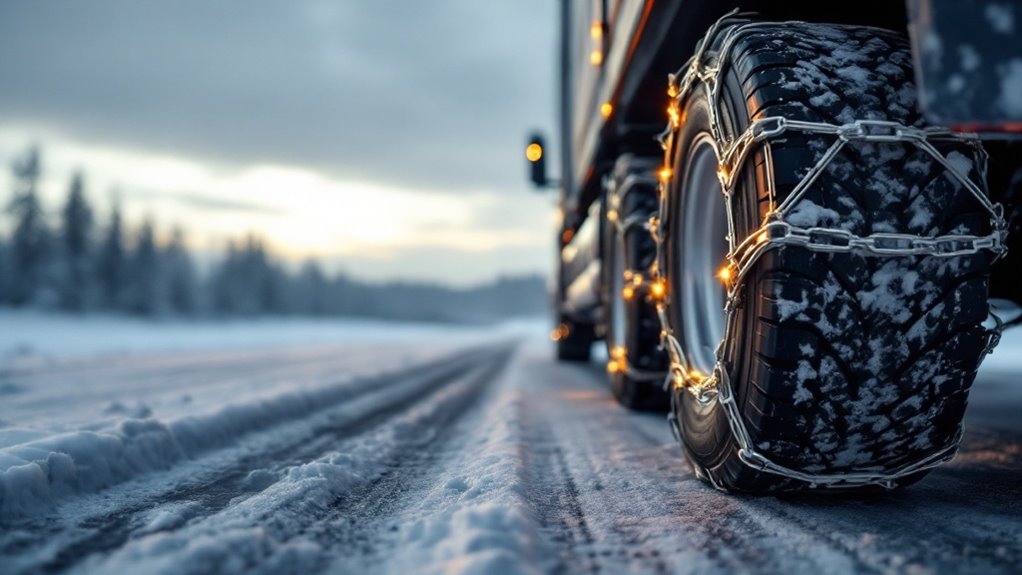
Let’s talk about rules for commercial vehicles. These big trucks need extra care. Their size affects road safety a lot. Drivers must follow strict chain rules. These rules change by state and emergency level. Stay ready for any situation.
At Level 1, single-axle trucks chain four drive tires. At Level 2, chain all drive tires. At Level 3, every vehicle needs chains. No excuses here. Certain roads may prohibit chains to protect road surfaces, so always be aware of local regulations.
Check chains often for damage. Make sure they meet rules. For example, use nine cross chains per tire. In Washington, carry chains if over 10,000 lbs. This rule applies from November 1 to April 1. It covers specific routes only. Not following risks fines or highway removal. Always plan ahead. Understanding these regulations ensures compliance with laws.
Quick guide for chain rules:
- Level 1: Chain single-axle drive tires.
- Level 2: Chain all drive tires.
- Level 3: Chains on everyone.
Weather and Road Conditions Requiring Chains
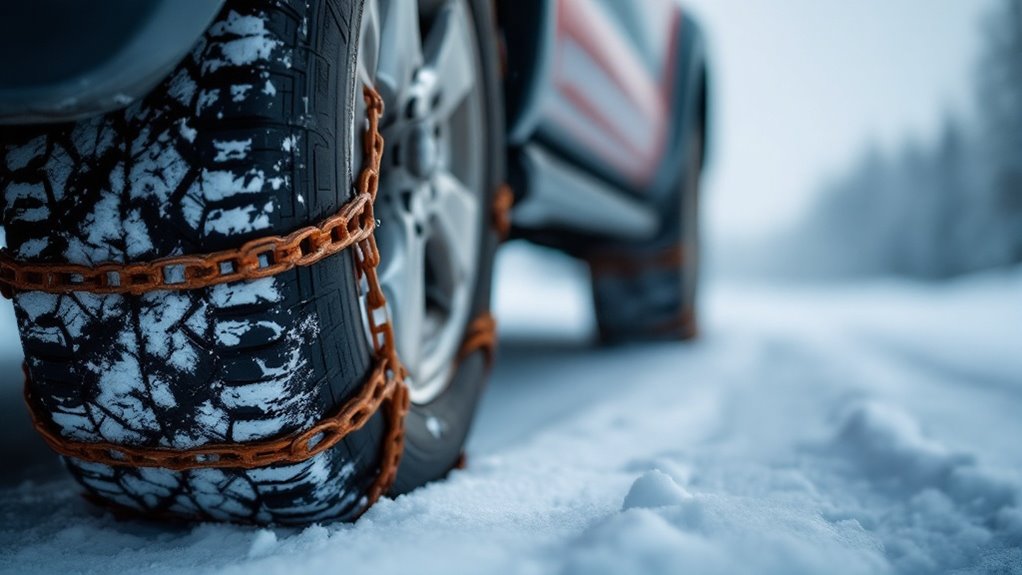
Many drivers deal with tough weather and bad roads in winter. Snow, ice, or slush can make driving risky. Tire chains help keep you safe on these roads. They give extra grip and stop your car from sliding. Always look at the weather report before you go. Quick freezes or black ice can strike fast. High mountain areas often see sudden changes too. Regulations on tire chain usage vary by state, so check specific laws before traveling to ensure compliance.
Check these situations to know if chains are a must:
| Road Type | Do You Need Chains? |
|---|---|
| Thick Snow on Roads | Yes, for better grip |
| Icy, Slippery Paths | Yes, to avoid crashes |
| Wet, Slushy Spots | Good idea for safe driving |
Stay ready for surprises like fog or sudden snow. Lake-effect snow can hit hard and fast. Keeping tire chains handy to tackle these dangers is essential for winter preparedness.
Specific Highways With Mandatory Chain Rules
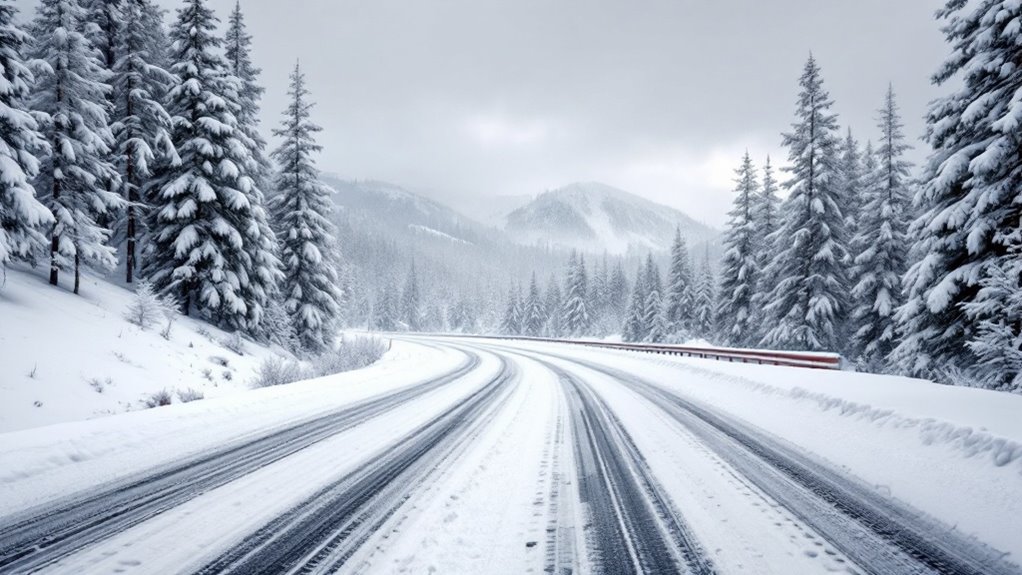
Driving on winter roads can be tricky. Sudden weather changes catch many off guard. Know the rules about tire chains to stay safe. Some highways have strict chain laws. Follow them to avoid fines or crashes.
Look at Colorado’s I-70 as an example. Commercial vehicles must carry chains there. This rule runs from September 1 to May 31. It prepares drivers for surprise snowstorms. Safety matters on this busy road.
California has tough rules too. On highways like I-80 and US-50, chains are key. Storms make these roads dangerous without them. Rules say most vehicles need chains. Only cars under 6,000 pounds with snow tires skip this. Always check the latest updates before you go.
Here’s a simple list to remember:
- I-70, Colorado: Chains needed for big trucks, September to May.
- California Roads: Chains required on I-80, US-50 during bad weather.
Types of Chains and Compliance Standards
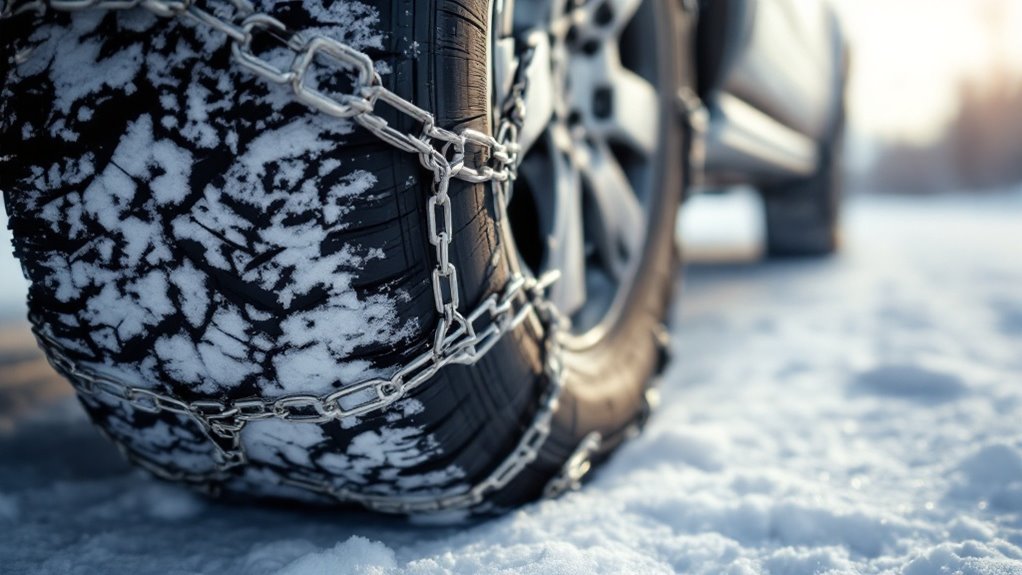
Driving on winter roads needs good prep. Know your tire chains and rules. Safety and staying legal matter a lot. Let’s break it down simply.
You got options for tire chains. Link chains are super tough. They give awesome grip with strong metal links.
Cable chains weigh less. They’re easy to put on for short drives.
Tire socks use fabric, not steel. They harm roads less and help the environment.
Rules change by place. Some areas need diamond-pattern chains. They make highway rides smoother.
Other spots ban chains to save nature. Always check local laws. Pick the right type and fit.
Here’s a fast list for you:
- Link Chains: Top strength, best grip.
- Cable Chains: Light, simple to use.
- Tire Socks: Kind to roads, eco-safe.
Make sure chains match your tires. Quality counts too. State laws often set strict standards. Stay safe and follow them on icy roads. Proper tire chain usage ensures safety and efficiency in winter driving conditions.
Penalties for Non-Compliance With Chain Laws
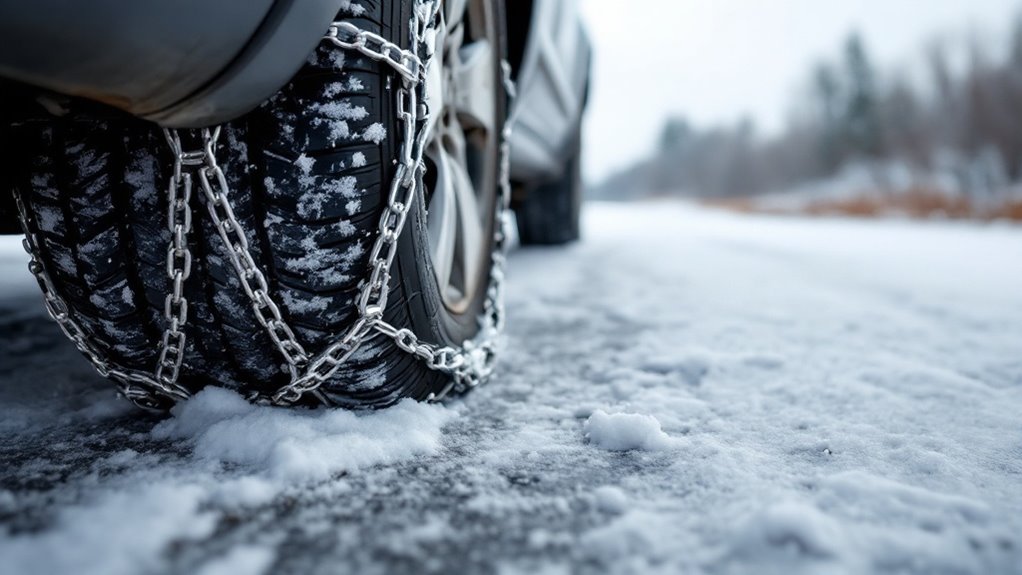
Tire chain laws matter a lot in winter. Ignoring them brings big trouble. Drivers face serious fines for not using chains. States have different rules and penalties.
California charges a $300 fine plus a point. Colorado fines start at $25, going up to $500. Block a highway in Colorado? Fines hit $1,000!
Some places enforce laws strictly. Colorado uses alert levels for tougher fines. Drivers might need to turn back. Or wait until roads open again.
Not following rules risks crashes. It also delays everyone on the road. Commercial trucks face even harsher penalties. Their size affects traffic more.
Violations aren’t moving offenses. Still, they raise insurance costs. They can hurt driving rights too.
Stay safe and follow chain laws!
Tips for Safe and Legal Chain Usage
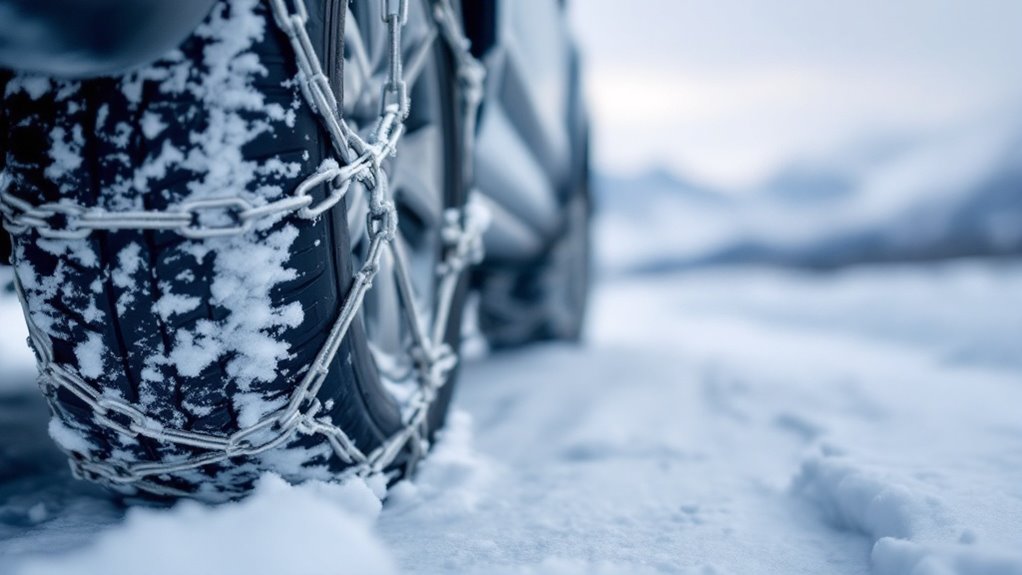
Tire chains keep you safe on winter roads. They help in tough, icy conditions. Learn to use them right for safety and to follow laws. Let’s break it down step by step.
First, lay the chains flat on the ground. Make sure no tangles exist. Picture a cold, snowy day with gray skies above.
Next, roll your car slowly onto the chains. Hear the tires crunch on icy ground. Then, lock the connectors tight. Listen for a sharp click in the quiet.
Drive just 15 feet and stop. Check and tighten the chains to avoid looseness.
Take care of your chains after use. Clean off snow and salt fast. Look for any damage or wear. Store them in a dry place to stop rust. Data shows rusty chains fail 30% faster. Remember, using tire chains can significantly improve driving safety in winter conditions.
Always know the local rules for chains. Drive slower, under 30 miles per hour. Take chains off on dry roads. Stay safe and avoid trouble with these tips.
Frequently Asked Questions
Can Tire Chains Damage My Vehicle’S Tires?
Got, do tire chains hurt your vehicle’s tires? Not at all, with proper care! Maintain those chains well. Make sure they fit your tires perfectly. Use them the right way every time. This stops any expensive damage. Trust me, it’s easy to avoid trouble! Studies show most tire issues come from wrong use. Stick to simple steps. Keep your tires safe and sound!
Are Tire Chains Allowed on Rental Cars?
Think about icy roads and rental cars with tire chains. Most rental companies say no to chains. Their rules often stop you from using them. This can clash with snow driving laws. Always read the rental agreement first. Don’t get caught in a tough spot! Check the policy to stay safe. Many areas require chains in bad weather. Know the rules before you drive. Stay prepared for snowy trips!
Do Tire Chains Affect Fuel Efficiency?
Tire chains can change how much fuel your car uses. They might cut efficiency on dry roads. But on snowy paths, they stop slipping. This can save fuel on icy ground. Ever wonder about safety? Chains help you drive better in bad weather. Studies show a small drop in gas mileage with chains. Still, safety matters more than a little fuel loss. Think about it—safe driving beats saving a few bucks!
Can I Use Tire Chains Year-Round?
Are, curious about using tire chains all year? Let’s break it down. First, check your local rules. Many places allow chains only in winter. Using them outside this time might get you fines. Proper setup of chains matters a lot. Wrong setup can harm roads or your car. Always double-check the fit before driving. Stay safe and avoid trouble. Stick to the laws for peace of mind.
Are There Alternatives to Tire Chains?
Did you hear that 60% of drivers pick lighter traction tools? Try tire socks for super easy setup. Snow cables also give solid grip on icy roads. Check out these smart and simple options now!
Conclusion
Tire chains can save lives on icy roads. Don’t ignore the laws about them. Breaking rules might lead to big fines. Worse, it could cause bad accidents. Always look up your state’s tire chain rules. Carry the right chains with you. Make sure to put them on correctly. Safety matters for you and others. Stay smart and follow the laws. No shortcuts on this! Data shows many crashes happen without chains. Protect yourself on tricky highways. Keep everyone safe with proper gear. Act now—don’t wait for trouble.
